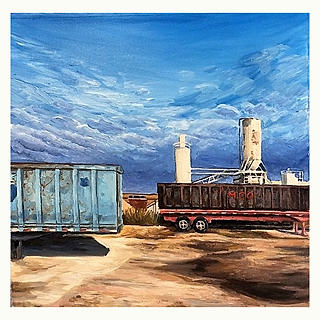A Glimpse at Fabric in Paintings
- Mandy Halford
- Jan 21, 2018
- 4 min read
You may think it a euphemism that observational work would need explaining. Wouldn’t something drawn or painted to capture what is of this world be as simple as that? Sure, I cannot force a deeper meaning or narrative to all realist works. Some art exists or was created simply because the artist loves studying the world around them. Others use known images that are recognizable to relay a story, historical event, or represent a specific emotion or idea. I recently got to thinking about how some objects are recurring in realist paintings throughout history, fabrics being notorious for their presence in many works of art. Why do seemingly random objects keep reoccurring in paintings throughout history, and what draws so many artists to paint them?
Potted plants are something that have been used in the past and are even more popular today. Lucien Freud and Paul Cezanne for example both did several works with potted plants either as the focus or located somewhere in the painting. At a recent trip to a Baroque exhibit at the Currier Museum of Art, I noticed the clothes the figures are wearing battle for your attention just as much as the painted figures, and I realized how nothing has stood the test of time in art as much as fabric has. Why do we artists love painting it so much?
To jump into the entangled relationship of fabric and art I’ll spare you the full history of painting cloth and just note that it originated in paintings as soon as humans originated in paintings. We could go as far back to Mesopotamian art where the attire is very simple and depicted as such and watch as it becomes more elaborately draped and tied to the figure in early Roman art.
For artists who love trying to capture light and value on objects its not hard to wonder what is so appealing about fabric. It’s a perfect object for beginners to practice their understanding of chiaroscuro, and it’s versatility can hold the interest of even master artists. It’s versatility is not only in its values, hues, and patterns but also that it can be placed in different positions to help construct a composition to suggest movement in the context, and to direct the viewers eyes over the whole canvas. Fabric can also be used to help with color relations within the piece and add colors to certain areas of the painting, .
But cloth in art can be more than just an object of study, or design element, it can represent all kinds of meanings and emotions. Is it a veiling an idea or hinting that something is not what it seems - yet to be unveiled? Is it a subconscious psychological fascination with our inability to be nude creatures? Are we fascinated with the cloth we use to cover ourselves just as we are fascinated with the human body? Some believe that this love of observation that some artists have is represented by the fabric itself. That fabric merely represents the canvas on which the artist paints and therefore the artists’ love of art.
“A painting is a piece of cloth. It is the membrane between the artist and the spectator. Depictions of cloth in a painting represent the painting itself and its contents. As a spectator we must look at, and through, and beyond the fabric presented to us before we can ever discern the significance of a work of art.” -Richard Baker
Of course the meaning of a piece is just as varied as the artist, so you can only wonder the next time you observe a new or old work of art that has that blanket tossed in the corner what they are trying to tell you. To quote Richard Baker again:
“Subject, content, and meaning remain undercover and we are spies attempting a glimpse. No matter how legible its message, any good painting, will, like a curtain, a veil, a shroud, a cloth resist in fully disclosing its contents. The completeness and clarity of meaning should always remain partly beneath cover. In our human condition and in the condition of our pictures, truth or meaning can never be a fixed and certain thing.”
Understanding something that mostly serves aesthetic purposes may not seem like the most imperative knowledge to seek. But maybe try thinking of art as a great novel. Sure it isn’t paramount that we read for survival but if it isn’t encouraged it is definitely respectable for one to be well read. For with every book we gain insight, experiences, empathy, imagination, and knowledge through the words we read and our world seems to grow a little bit larger. I think within a great painting there is a novel hidden away, and once you start to observe a few aspects of art you will be opened to that visual library of the world.
*Quoted in Article : Richard Baker "The Power of Observation" 2010
*Still Curious? Check out this article for more info on the History side:
The New York Times: Art/Architecture; The Folds Hinted More Than They Hid, 2002 by Alan Riding





Comments